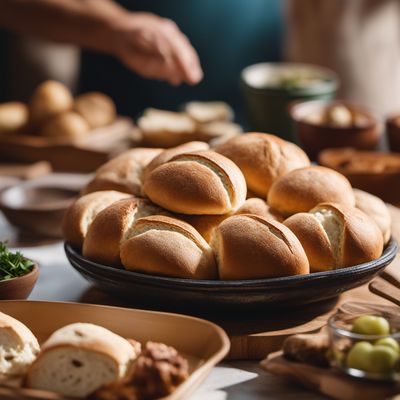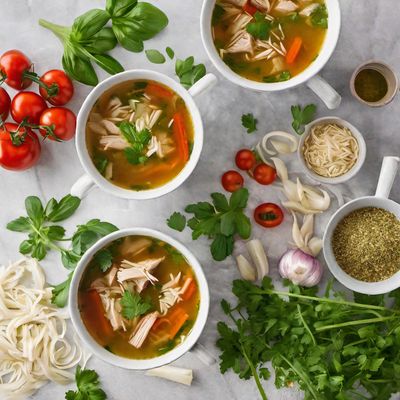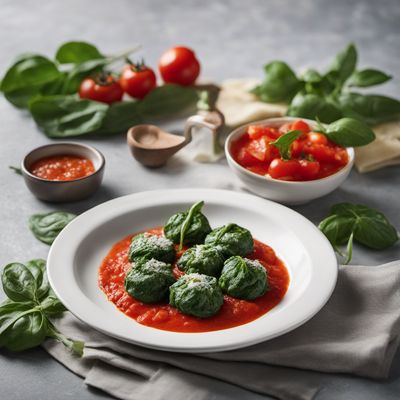
Recipe
Korean Chinese Buckwheat Noodles
Savory and Spicy Buckwheat Noodles with Korean Chinese Flair
4.7 out of 5
This recipe combines the nutty flavor of buckwheat noodles with the bold and spicy flavors of Korean Chinese cuisine. It is a delightful fusion dish that brings together the best of both worlds.
Metadata
Preparation time
15 minutes
Cooking time
10 minutes
Total time
25 minutes
Yields
4 servings
Preparation difficulty
Easy
Suitable for
Vegetarian, Vegan, Dairy-free, Nut-free, Gluten-free (if using gluten-free buckwheat noodles)
Allergens
Soy (in soy sauce), Sesame seeds
Not suitable for
Paleo, Keto, Low-carb, High-protein, High-fat
Ingredients
In this Korean Chinese adaptation, the original Italian buckwheat noodles are transformed into a spicy and savory dish. The Italian flavors are replaced with Korean Chinese flavors by using ingredients like Korean chili paste, soy sauce, garlic, and ginger. The dish is also garnished with fresh vegetables and sesame seeds, which adds a refreshing crunch and enhances the visual appeal. We alse have the original recipe for Strascinati di grano saraceno, so you can check it out.
-
250g (8.8 oz) buckwheat noodles 250g (8.8 oz) buckwheat noodles
-
2 tablespoons vegetable oil 2 tablespoons vegetable oil
-
2 cloves garlic, minced 2 cloves garlic, minced
-
1 tablespoon ginger, grated 1 tablespoon ginger, grated
-
2 tablespoons Korean chili paste (gochujang) 2 tablespoons Korean chili paste (gochujang)
-
2 tablespoons soy sauce 2 tablespoons soy sauce
-
1 tablespoon rice vinegar 1 tablespoon rice vinegar
-
1 tablespoon honey 1 tablespoon honey
-
1 cup mixed vegetables (carrots, bell peppers, cabbage), julienned 1 cup mixed vegetables (carrots, bell peppers, cabbage), julienned
-
2 green onions, sliced 2 green onions, sliced
-
1 tablespoon sesame seeds 1 tablespoon sesame seeds
-
Salt, to taste Salt, to taste
Nutrition
- Calories (kcal / KJ): 320 kcal / 1340 KJ
- Fat (total, saturated): 8g, 1g
- Carbohydrates (total, sugars): 55g, 8g
- Protein: 9g
- Fiber: 6g
- Salt: 2g
Preparation
-
1.Cook the buckwheat noodles according to the package instructions. Drain and set aside.
-
2.In a large pan, heat the vegetable oil over medium heat. Add the minced garlic and grated ginger, and sauté for 1-2 minutes until fragrant.
-
3.Add the Korean chili paste, soy sauce, rice vinegar, and honey to the pan. Stir well to combine the ingredients and let the sauce simmer for 2-3 minutes.
-
4.Add the cooked buckwheat noodles to the pan and toss them in the sauce until well coated. Cook for an additional 2-3 minutes to heat the noodles through.
-
5.Add the julienned mixed vegetables and sliced green onions to the pan. Stir-fry for 2-3 minutes until the vegetables are slightly tender but still crisp.
-
6.Season with salt to taste and sprinkle sesame seeds over the noodles.
-
7.Remove from heat and transfer the Korean Chinese Buckwheat Noodles to a serving dish.
-
8.Serve hot and enjoy!
Treat your ingredients with care...
- Buckwheat noodles — Cook the noodles according to the package instructions, but make sure not to overcook them as they can become mushy. Rinse them with cold water after cooking to prevent sticking.
- Korean chili paste (gochujang) — Adjust the amount of chili paste according to your spice preference. If you prefer a milder flavor, reduce the amount slightly.
Tips & Tricks
- For added protein, you can add cooked chicken, beef, or tofu to the dish.
- Customize the vegetable mix according to your preference or what's in season.
- If you prefer a sweeter flavor, increase the amount of honey in the sauce.
- Garnish with additional sliced green onions and sesame seeds for extra flavor and presentation.
- Serve the noodles with a side of kimchi for an authentic Korean touch.
Serving advice
Serve the Korean Chinese Buckwheat Noodles hot as a main dish. It can be enjoyed on its own or paired with a side of kimchi for a complete meal.
Presentation advice
To enhance the presentation, arrange the julienned vegetables on top of the noodles in an appealing pattern. Sprinkle additional sesame seeds and sliced green onions on top for a pop of color.
More recipes...
For Strascinati di grano saraceno
For Italian cuisine » Browse all
For Korean Chinese cuisine » Browse all
More Italian cuisine dishes » Browse all

Zuppa Inglese Gelato
English Soup Gelato
Zuppa Inglese Gelato is a classic Italian dessert that is perfect for any occasion. It is a rich and creamy dessert that is sure to impress your guests.

Sportella
Sportella is a traditional Maltese bread that is typically eaten as a snack or with a meal. It is a savory bread that is perfect for dipping in...

Fritto misto di pesce
Fritto misto di pesce is a popular Italian seafood dish that is typically served as an appetizer.









